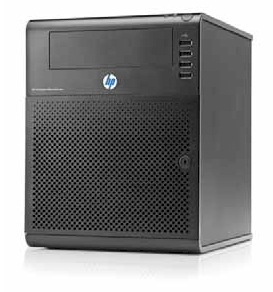This article is more than 1 year old
HP punts MicroServer for SMBs
Honey, I shrunk the ProLiants
Hewlett-Packard is keen on scaring up some business at small and medium businesses, and today will dust off the old MicroServer brand from Digital Equipment and slap it on a new entry ProLiant x64 server aimed expressly at cheapskates who don't want or need a full-on ProLiant tower, rack, or blade box.
It may look a bit like a space heater, but the new ProLiant MicroServer - no ML100 or such designation for this box - is a real server with all the things that make a ProLiant machine trustworthy, says Jim Ganthier, vice president of marketing for HP's Industry Standard Servers division. And is expressly designed to meet the needs of companies with one to nine employees who have been using federated notebooks and PCs with some shared storage (or not) instead of buying a server.
Yes, that is so 1989. But the vast majority of the 37 million small and medium businesses in the world are retro and too damned sensible or stingy to spend a few grand of their own hard-earned cash on a glorified disk drive with some file sharing. Most SMBs do not have a lot of experience with setting up and maintaining computers - much less an IT department - and so they don't buy servers.
Cheap entry servers have been available for years - Dell and Fujitsu get a lot of their volumes down here, and so does HP for that matter - but the idea behind the MicroServer is to make a real server, not just a glorified PC, and to get it out there for a very low street price. And some customers will no doubt find more uses for a server once they have one and will therefore outgrow the MicroServer, which has only one configuration, and then graduate to a proper ProLiant ML tower server or perhaps even some racks or blades as they grow their businesses. So the MicroServer is an on-ramp to a data center, much as Windows on the desktop inevitably leads to Windows on the server for many SMBs, and therefore has made Windows the dominant server platform after 15 years of marketing. In this regard, HP's dominant PC business coupled with the MicroServer is a defensively play as much as an offensive one.

This is a server, not a space heater.
The HP MicroServer is based on a dual-core Athlon II Neo N36L processor from Advanced Micro Devices and this single-socket box has precisely one speed for the cores: at 1.3 GHz. The chip has 2 MB of on-chip cache. The MicroServer uses cheap 800 MHz DDR3 main memory, and has only two memory slots, maxxing out at 8 GB using two 4 GB memory sticks. The memory has unbuffered ECC scrubbing. The memory is accessible behind the front grill, which is interesting, and so are four pluggable, 2 TB, 3.5-inch SATA drive bays. (Pluggable does not mean hot plugging. You have to power down the server to add disks.) The system board comes with a SATA disk controller that can be configured to mirror disks, but it does not have RAID 5 or RAID 6 data protection. The mobo in the box has two PCI-Express slots, one x1 and one x16. The tower measures 10.5 by 10.2 by 8.3 inches, which means you can put it on a desk or under a desk or in a closet; it has a 200 watt power supply, and is quiet enough (at 22 decibels) for an office environment (unlike most other ProLiant servers, which will make you go deaf). The MicroServer has a single Gigabit Ethernet adapter on the motherboard and the server can have an optional DVD drive and remote access card for remote management by HP or its channel partners. The server has seven USB ports (four in the front, two in the back, and one internal) and one eSATA port (in the back).
The MicroServer comes with a one-year warranty and is available globally from HP and its channel partners. Ganthier says the MicroServer is actually manufactured in several locations around Asia rather than at the HP factories in Houston, and that is one of the reasons why HP can get the price for the base box down to $329. That configuration comes with 1 GB of memory and no disk. A useful configuration with an additional 4 GB of memory, one 2 TB disk, a DVD drive, and the remote access card will set you back $1,575. (Funny how that adds up fast, eh?) Neither of those prices include an operating system.
The MicroServer can be configured to run the Foundation or Standard Edition of Microsoft's Windows Server 2008 R2 or Red Hat's Enterprise Linux 5.
In addition to launching the MicroServer, Ganthier says that HP is working with channel partners to set up the MicroServer as a base box for turnkey solutions, much as SCO Unix used to be a default operating system running on ProLiant towers and supporting myriad industry-specific and generic financial applications. Intuit, Sage, and Peachtree are the obvious first partners for such a baby biz box, but Ganthier did not name names because the turnkey setups are not ready yet. ®
